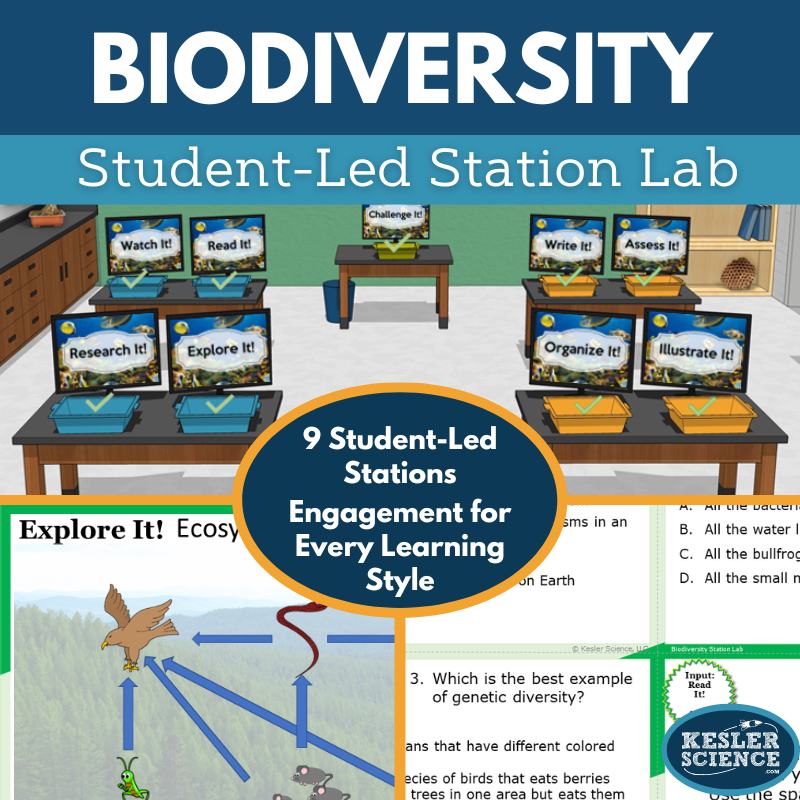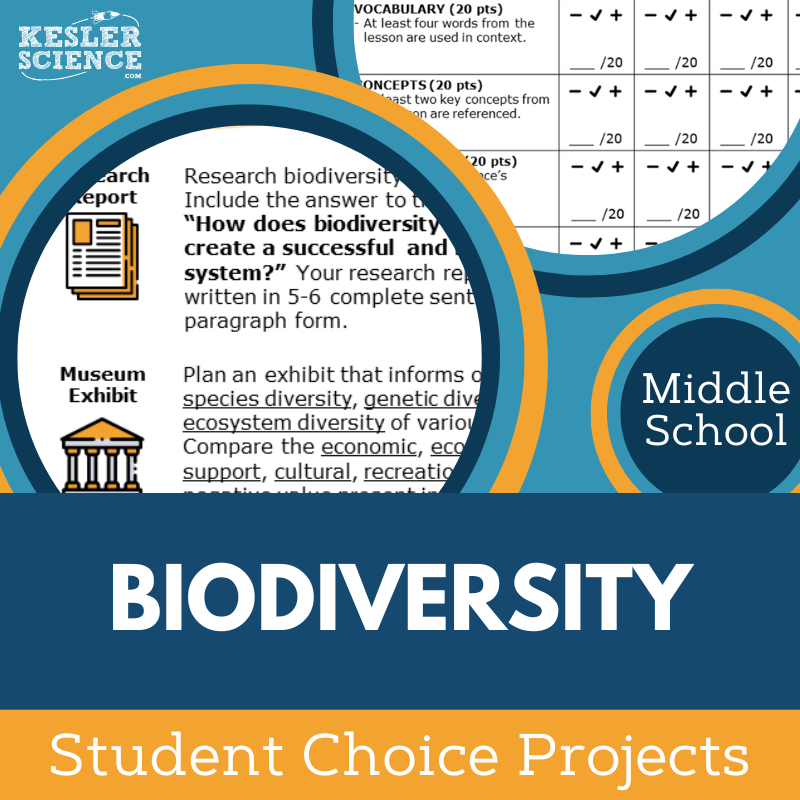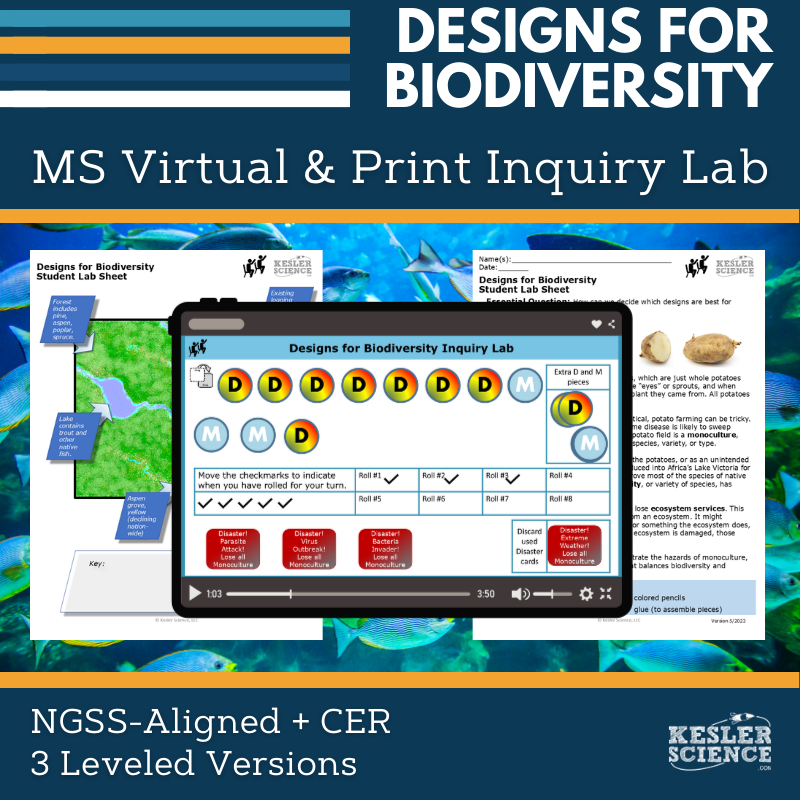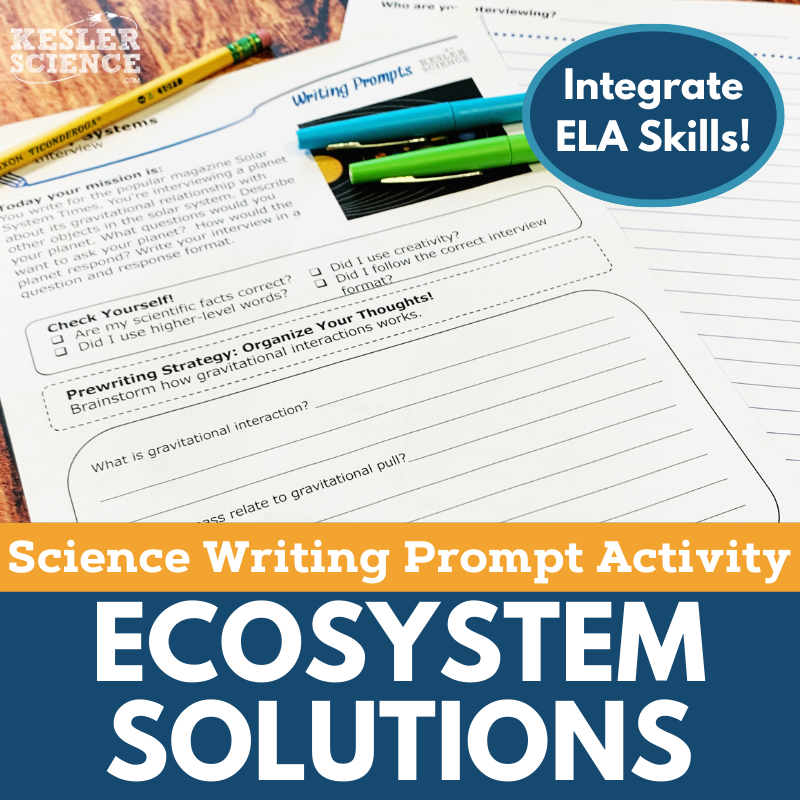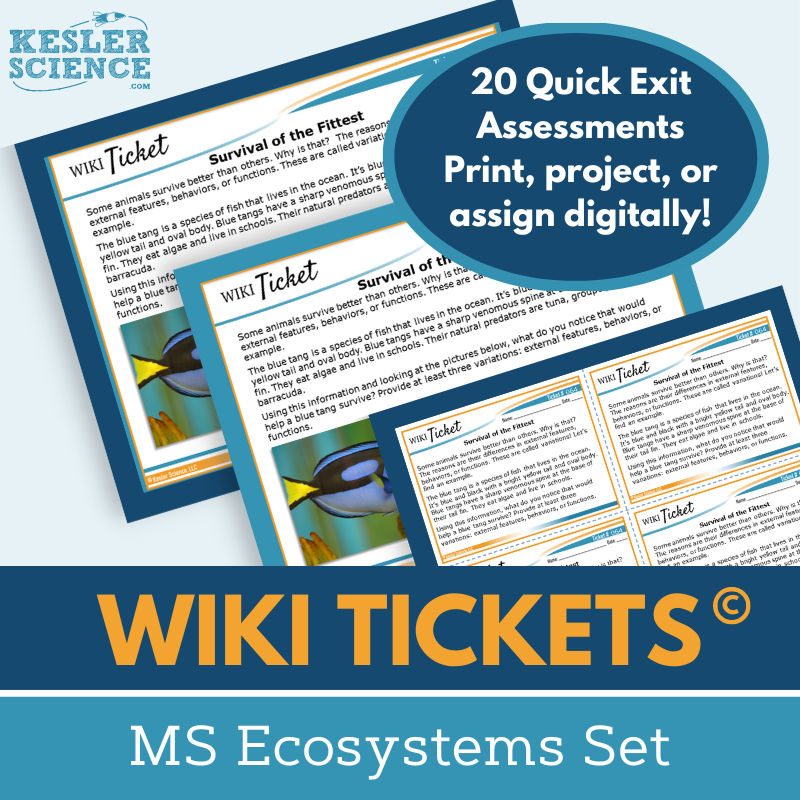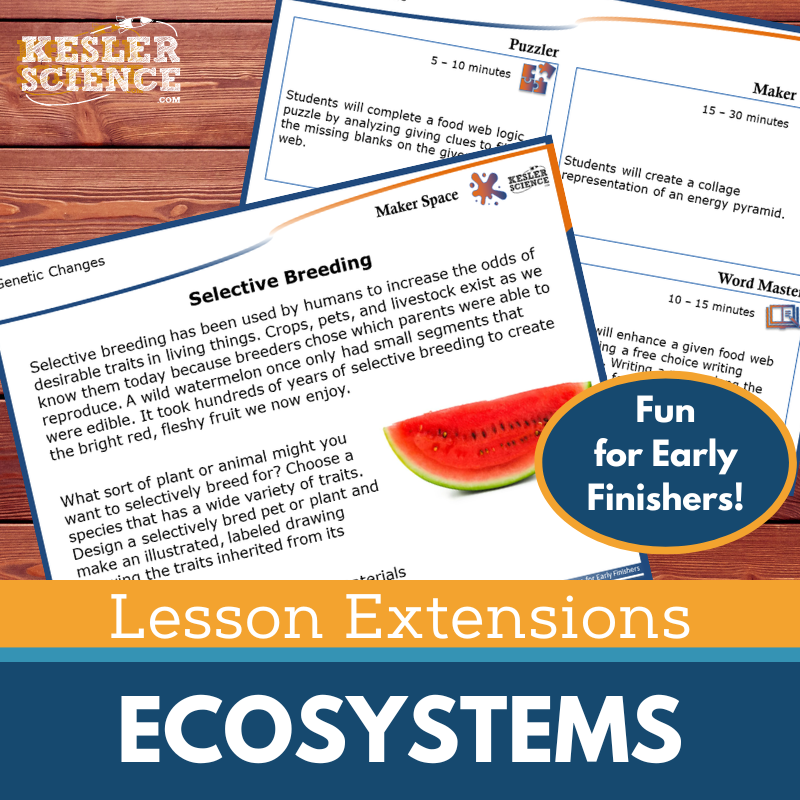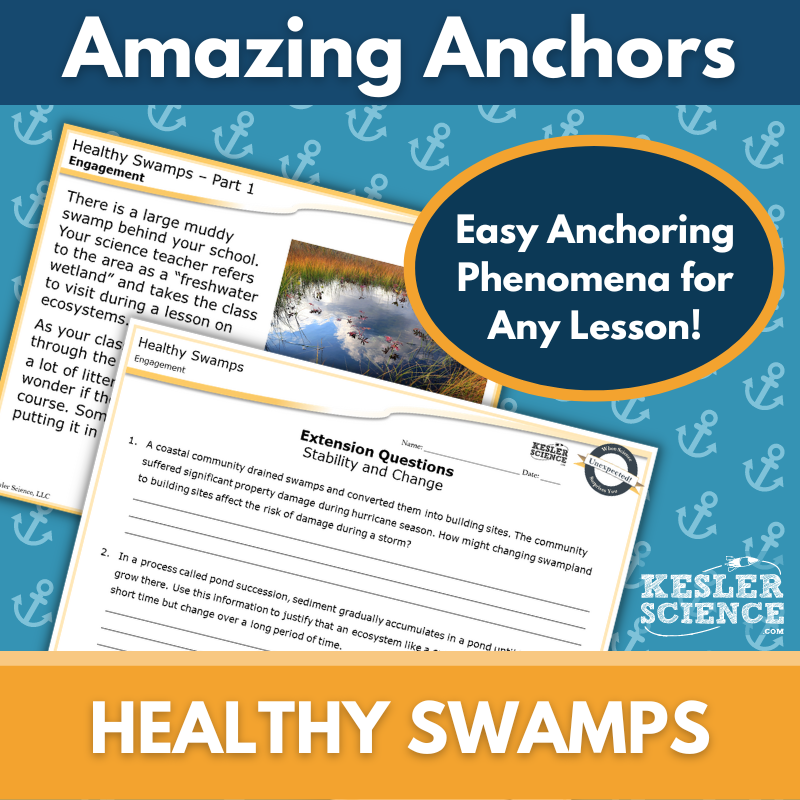Designs for Biodiversity Activities for Middle School Science
Kesler Science Biodiversity 5E Lesson engages middle school students in exploring how biodiversity supports ecosystem sustainability. The resources below will give students a comprehensive understanding of designs for biodiversity. All of the following materials are also included in the Kesler Science Membership.
The Kesler Science Biodiversity 5E Lesson is a comprehensive, student-led unit designed for middle school, aligned with TEKS. and NGSS standards. It includes editable presentations, worksheets, choice projects, and assessments, requiring minimal prep while supporting differentiated learning. The lesson explores how biodiversity contributes to ecosystem sustainability through multimodal and flexible formats, including printable and digital options. Spanish translations are available for key materials.
The 5E Model structure provides engaging content for each phase. In Engagement, students discuss key concepts using word wall cards and class activities. The Exploration phase features a differentiated station lab with nine stations, including hands-on experiments, reading passages in English and Spanish, research tasks, videos, and interactive activities. Explanation includes editable PowerPoints, interactive notebooks, and note-taking templates. For Elaboration, student-choice projects deepen understanding. Evaluation consists of updated STAAR 2.0-aligned assessments and review worksheets.
Designed for both in-class and virtual learning, this lesson ensures accessibility and engagement through student-centered activities, allowing teachers to focus on student success.
The Kesler Science Biodiversity 5E Lesson is a comprehensive, student-led unit designed for middle school, aligned with TEKS. and NGSS standards. It includes editable presentations, worksheets, choice projects, and assessments, requiring minimal prep while supporting differentiated learning. The lesson explores how biodiversity contributes to ecosystem sustainability through multimodal and flexible formats, including printable and digital options. Spanish translations are available for key materials.
The 5E Model structure provides engaging content for each phase. In Engagement, students discuss key concepts using word wall cards and class activities. The Exploration phase features a differentiated station lab with nine stations, including hands-on experiments, reading passages in English and Spanish, research tasks, videos, and interactive activities. Explanation includes editable PowerPoints, interactive notebooks, and note-taking templates. For Elaboration, student-choice projects deepen understanding. Evaluation consists of updated STAAR 2.0-aligned assessments and review worksheets.
Designed for both in-class and virtual learning, this lesson ensures accessibility and engagement through student-centered activities, allowing teachers to focus on student success.
Engage your middle school students in an interactive, student-led exploration of biodiversity with this station lab. Designed to promote independent learning, this low-prep resource allows students to identify and compare characteristics of biodiversity through nine hands-on and digital activities.
Students encounter new concepts through multimodal input stations, including hands-on demonstrations, research tasks, reading passages in English and Spanish, and video analysis. Output stations challenge students to organize information, illustrate models, write responses, and complete assessments. A bonus challenge station offers extension activities like crosswords, games, and mini projects for early finishers.
This versatile resource includes all necessary signage, task cards, and digital options for virtual learning, making it an adaptable and engaging addition to any middle school science curriculum.
Engage your middle school students in an interactive, student-led exploration of biodiversity with this station lab. Designed to promote independent learning, this low-prep resource allows students to identify and compare characteristics of biodiversity through nine hands-on and digital activities.
Students encounter new concepts through multimodal input stations, including hands-on demonstrations, research tasks, reading passages in English and Spanish, and video analysis. Output stations challenge students to organize information, illustrate models, write responses, and complete assessments. A bonus challenge station offers extension activities like crosswords, games, and mini projects for early finishers.
This versatile resource includes all necessary signage, task cards, and digital options for virtual learning, making it an adaptable and engaging addition to any middle school science curriculum.
The Biodiversity Student Choice Projects lesson allows middle school students to demonstrate their understanding in a way that suits their learning style. A project page outlines six student-led options along with a “design your own” project, offering a range of creative and engaging ways to explore biodiversity concepts. An editable rubric provides flexibility for teacher, peer, or self-assessment, ensuring clear evaluation criteria.
These projects are designed to be adaptable and accessible for all learners. Two versions of the project page support differentiation, with modified options for students who need remediation and challenge opportunities for advanced learners. Teachers can mix and match projects while using the same rubric, making it easy to customize instruction and assessment. The multimodal approach encourages critical thinking and creativity, allowing students to showcase their knowledge in unique ways.
Minimal materials are required, as most projects can be completed using standard classroom supplies such as paper, markers, and scissors. Many options also allow for digital completion, making the projects versatile for different learning environments. Whether students prefer hands-on activities, digital presentations, or artistic expressions, this lesson provides meaningful opportunities for engagement and deeper understanding of biodiversity.
The Biodiversity Student Choice Projects lesson allows middle school students to demonstrate their understanding in a way that suits their learning style. A project page outlines six student-led options along with a “design your own” project, offering a range of creative and engaging ways to explore biodiversity concepts. An editable rubric provides flexibility for teacher, peer, or self-assessment, ensuring clear evaluation criteria.
These projects are designed to be adaptable and accessible for all learners. Two versions of the project page support differentiation, with modified options for students who need remediation and challenge opportunities for advanced learners. Teachers can mix and match projects while using the same rubric, making it easy to customize instruction and assessment. The multimodal approach encourages critical thinking and creativity, allowing students to showcase their knowledge in unique ways.
Minimal materials are required, as most projects can be completed using standard classroom supplies such as paper, markers, and scissors. Many options also allow for digital completion, making the projects versatile for different learning environments. Whether students prefer hands-on activities, digital presentations, or artistic expressions, this lesson provides meaningful opportunities for engagement and deeper understanding of biodiversity.
The Biodiversity and Ecosystem Services Inquiry Lab aligns with NGSS MS-LS2-5, guiding students to evaluate competing design solutions for maintaining biodiversity. This lab offers both digital and hands-on print versions, each including comprehension questions, Claim-Evidence-Reasoning (C.E.R.) prompts, and a reflection section.
Students begin by playing a game to explore how biodiversity strengthens ecosystems compared to monoculture. They then analyze a fictional land map donated to the government and assess various designs for its use. The lab is available in three differentiated levels—Dependent for on-level learners, Modified for those needing additional support, and Independent for advanced learners—ensuring accessibility for all students.
The print version provides a structured, hands-on experiment where students use biodiversity cards, diverse/monoculture pieces, colored pencils, glue, and a zip-close bag. The digital version is an interactive PowerPoint compatible with Google Slides, requiring no physical materials and making it ideal for remote learning or absent students.
Editable teacher resources include PowerPoints, answer keys, standards-aligned objectives, teacher guides, and multimodal activities designed to keep middle school students engaged. This flexible lab can be easily integrated into various learning platforms such as MS Teams, Schoology, and Canvas.
The Biodiversity and Ecosystem Services Inquiry Lab aligns with NGSS MS-LS2-5, guiding students to evaluate competing design solutions for maintaining biodiversity. This lab offers both digital and hands-on print versions, each including comprehension questions, Claim-Evidence-Reasoning (C.E.R.) prompts, and a reflection section.
Students begin by playing a game to explore how biodiversity strengthens ecosystems compared to monoculture. They then analyze a fictional land map donated to the government and assess various designs for its use. The lab is available in three differentiated levels—Dependent for on-level learners, Modified for those needing additional support, and Independent for advanced learners—ensuring accessibility for all students.
The print version provides a structured, hands-on experiment where students use biodiversity cards, diverse/monoculture pieces, colored pencils, glue, and a zip-close bag. The digital version is an interactive PowerPoint compatible with Google Slides, requiring no physical materials and making it ideal for remote learning or absent students.
Editable teacher resources include PowerPoints, answer keys, standards-aligned objectives, teacher guides, and multimodal activities designed to keep middle school students engaged. This flexible lab can be easily integrated into various learning platforms such as MS Teams, Schoology, and Canvas.
This Biodiversity and Ecosystem Services Reading Comprehension Lesson engages middle school students with a nonfiction article on designing for ecosystems. Students answer comprehension questions and research the pros and cons of three flooding solutions.
The resource includes a leveled science passage (Lexile 1100-1300), five to seven comprehension questions, and a hands-on mini-project. A Cornell notes template is provided for additional support.
Designed for grades 6-8 (and advanced 5th graders), this lesson fosters science literacy and critical thinking. It can be used for whole-class instruction, sub plans, extra credit, ISS, or virtual learning through platforms like Google Classroom, MS Teams, Schoology, and Canvas.
This Biodiversity and Ecosystem Services Reading Comprehension Lesson engages middle school students with a nonfiction article on designing for ecosystems. Students answer comprehension questions and research the pros and cons of three flooding solutions.
The resource includes a leveled science passage (Lexile 1100-1300), five to seven comprehension questions, and a hands-on mini-project. A Cornell notes template is provided for additional support.
Designed for grades 6-8 (and advanced 5th graders), this lesson fosters science literacy and critical thinking. It can be used for whole-class instruction, sub plans, extra credit, ISS, or virtual learning through platforms like Google Classroom, MS Teams, Schoology, and Canvas.
The Ecosystem Solutions Science Writing Prompt Activity engages middle school students in a compare-and-contrast essay to reinforce their understanding of biodiversity and ecosystem services. Aligned with MS LS2-5, this student-centered activity enhances science reasoning and exploration while supporting both in-person and virtual learning.
This resource includes teacher directions with an answer guide, project ideas, and rubrics. It offers projection and print handouts in full-sized and half-sheet formats, featuring writing prompts, self-checks, pre-writing strategies, and layout templates. A digital interactive version is also included as a PowerPoint, compatible with Google Slides for remote or in-person learning.
Ideal for cross-curricular activities, pre-test assessments, student choice projects, early finisher elaboration, extra credit, make-up work, TELPAS samples, or differentiation, this writing prompt fosters engagement and science literacy. It can also be displayed on a bulletin board or compiled into student anthologies.
The Ecosystem Solutions Science Writing Prompt Activity engages middle school students in a compare-and-contrast essay to reinforce their understanding of biodiversity and ecosystem services. Aligned with MS LS2-5, this student-centered activity enhances science reasoning and exploration while supporting both in-person and virtual learning.
This resource includes teacher directions with an answer guide, project ideas, and rubrics. It offers projection and print handouts in full-sized and half-sheet formats, featuring writing prompts, self-checks, pre-writing strategies, and layout templates. A digital interactive version is also included as a PowerPoint, compatible with Google Slides for remote or in-person learning.
Ideal for cross-curricular activities, pre-test assessments, student choice projects, early finisher elaboration, extra credit, make-up work, TELPAS samples, or differentiation, this writing prompt fosters engagement and science literacy. It can also be displayed on a bulletin board or compiled into student anthologies.
These WIKI Tickets© Formative Assessments offer engaging, flexible ways to check student understanding of Ecosystems topics in 6th-8th grade science. The set includes 20 topics, each provided in five different formats: a full-screen projection version, three printable handouts (full-page, half-page, quarter-page), and an interactive digital version compatible with PowerPoint and Google Slides.
Aligned with middle school NGSS and TEKS standards, these versatile resources can serve as exit tickets, bellringers, or quick formative checks in both in-person and virtual classrooms. Topics include biodiversity, biotic and abiotic factors, taxonomy, ecological succession, food webs, human impacts, natural selection, photosynthesis, and environmental changes. A table of contents detailing standards alignment is included to help educators effectively track student progress.
These WIKI Tickets© Formative Assessments offer engaging, flexible ways to check student understanding of Ecosystems topics in 6th-8th grade science. The set includes 20 topics, each provided in five different formats: a full-screen projection version, three printable handouts (full-page, half-page, quarter-page), and an interactive digital version compatible with PowerPoint and Google Slides.
Aligned with middle school NGSS and TEKS standards, these versatile resources can serve as exit tickets, bellringers, or quick formative checks in both in-person and virtual classrooms. Topics include biodiversity, biotic and abiotic factors, taxonomy, ecological succession, food webs, human impacts, natural selection, photosynthesis, and environmental changes. A table of contents detailing standards alignment is included to help educators effectively track student progress.
Lesson Extensions offer engaging, student-choice activities aligned with NGSS and TEKS standards, specifically designed to challenge early finishers and deepen their understanding of ecosystems. These extensions provide rigorous yet enjoyable learning opportunities ideal for lesson wrap-ups, downtime during testing, or preventing distractions by keeping students actively engaged.
Each extension includes four interactive components: Puzzler for developing problem-solving skills, Maker Space for hands-on STEAM activities, Tech Connection for digital media demonstrations, and Word Master for creative writing exercises related to science. The resources come with teacher directions, answer keys, and both digital projection and print versions (full- and half-sheet sizes) for classroom flexibility.
This bundle covers diverse ecosystem topics, including biodiversity, biomes, biotic and abiotic factors, ecological succession, ecosystem changes, human impact, photosynthesis, resource availability, and many more, supporting high-level enrichment and independent learning.
Lesson Extensions offer engaging, student-choice activities aligned with NGSS and TEKS standards, specifically designed to challenge early finishers and deepen their understanding of ecosystems. These extensions provide rigorous yet enjoyable learning opportunities ideal for lesson wrap-ups, downtime during testing, or preventing distractions by keeping students actively engaged.
Each extension includes four interactive components: Puzzler for developing problem-solving skills, Maker Space for hands-on STEAM activities, Tech Connection for digital media demonstrations, and Word Master for creative writing exercises related to science. The resources come with teacher directions, answer keys, and both digital projection and print versions (full- and half-sheet sizes) for classroom flexibility.
This bundle covers diverse ecosystem topics, including biodiversity, biomes, biotic and abiotic factors, ecological succession, ecosystem changes, human impact, photosynthesis, resource availability, and many more, supporting high-level enrichment and independent learning.
This Amazing Anchors Phenomenon Lesson introduces and reinforces the concept of maintaining ecosystems through real-world connections. It begins with an engaging reading about cleaning a swamp, followed by comprehension and extension questions to prepare students for deeper learning. A second explanatory reading breaks down the science behind maintaining ecosystems, with additional questions to reinforce understanding.
Aligned with NGSS standard MS LS2-5, this no-prep resource includes teacher directions, answer keys, projection slides, and both print and digital formats for Google Classroom and other LMS platforms. A differentiated version provides sentence starters for student support. Designed to bookend a lesson, these engaging readings serve as supplements to reinforce learning in any in-person or virtual classroom.
This Amazing Anchors Phenomenon Lesson introduces and reinforces the concept of maintaining ecosystems through real-world connections. It begins with an engaging reading about cleaning a swamp, followed by comprehension and extension questions to prepare students for deeper learning. A second explanatory reading breaks down the science behind maintaining ecosystems, with additional questions to reinforce understanding.
Aligned with NGSS standard MS LS2-5, this no-prep resource includes teacher directions, answer keys, projection slides, and both print and digital formats for Google Classroom and other LMS platforms. A differentiated version provides sentence starters for student support. Designed to bookend a lesson, these engaging readings serve as supplements to reinforce learning in any in-person or virtual classroom.
Year-Round Resources
These year-round activities will increase your students' understanding of many middle school science topics. All of these activities are also included in the Kesler Science Membership.
Visual Data & Graphing
You're not alone if your students struggle with understanding graphs, charts, and tables. It's a skill that takes an enormous amount of practice. This resource will help students build a strong foundation in analyzing data and creating their own data visualizations.
Bell Ringers and Warm-Ups
These middle school science bell ringers are an excellent way to engage your students as soon as they walk into your classroom. This comprehensive FULL YEAR resource includes everything you need to start off each science class with an interesting warm-up activity.
Review Board Games
Each game board has been carefully designed to keep students engaged. There are 10 different action spaces on each board and dozens of question cards. All of the actions are related to science concepts and keep the students motivated throughout the game.
Each game is ready to play. Simply print out the board and the cards and let the students enjoy reviewing nine different units.
Essential Questions and Standards
Below are the essential questions and standards associated with the lessons and activities included in the designs for biodiversity unit. This topic is only one of more than 100 middle school science topics included in the Kesler Science Membership.
-
How does biodiversity contribute to the sustainability of an ecosystem?
-
NGSS - MS-LS2-5 Designs for Biodiversity
Kesler Science Membership
Imagine never having to search for another middle school science lesson again. The membership gives you access to ALL of the Kesler Science products in one place (Yes, including everything above).
Say goodbye to long hours of lesson prep.



